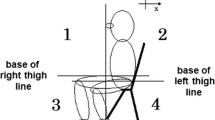Abstract
People generally display an important amount of gestural and motoric activity when speaking. Since recent data have shown the limits of an explanation of this activity in terms of nonverbal or bodily communication, the present study attempted to explore what would happen if subjects were impeded from making the principal movements they normally perform during a conversation. Subjects were led to hold a 50-minute conversation while sitting in an armchair devised to restrain their movements of the head, arms, hands, legs, and feet during part of the experiment. The main dependent variables consisted of nonverbal activity in body zones that remained free to vary: eyebrows, eyes, mouth, and fingers. During the phase of movement restriction, highly significant increases in activity were recorded in these zones, with subsequent return to base levels when the subject recovered free movements. Also, significant interactions of conditions of movements and subject's conversational role (speaker vs. listener) were observed for most of the variables. Samples of dialogues submitted to a computerized technique of content analysis revealed a significant decrease in the vividness of imagery during movement restriction.
Similar content being viewed by others
References
Argyle, M., & Cook, M. (1976).Gaze and mutual gaze. Cambridge: Cambridge University Press.
Cacioppo, J. T., & Petty, R. E. (1981). Electromyograms as measures of extent and affectivity information processing.American Psychologist, 36 441–456.
Goldman-Eisler, F. (1961a). A comparative study of two hesitation phenomena.Language and Speech, 4 18–26.
Goldman-Eisler, F. (1961b). The distribution of pause duration in speech.Language and Speech, 4 132–137.
Hogenraad, R., & Orianne, E. (1981). Valence d'imagerie de 1130 noms de la langue française.Psychologica Belgica, 21 21–30.
Lang, P. J. (1979). A bio-informational theory of emotional imagery.Psychophysiology, 16 495–512.
Martindale, C. (1978–1979). The night journey: Trends in the content of narrative symbolizing alterations of consciousness.Journal of Altered States of Consciousness, 4 321–343.
Osgood, C. E. (1957). Motivational dynamics of language behavior. In M. R. Jones (Ed.),Nebraska symposium on motivation. Lincoln: University of Nebraska Press.
Rimé, B. (1982a). Sensibilité des comportements non verbaux aux variations de la densité de communication.L' Année Psychologique, 82 173–187.
Rimé, B. (1982b). The elimination of visible behavior from social interactions: Effects on verbal, nonverbal and interpersonal variables.European Journal of Social Psychology, 12 113–129.
Rimé, B. (1983). Nonverbal communication or nonverbal behavior? Towards a cognitive-motor theory of nonverbal behavior. In W. Doise & S. Moscovici (Eds.),Current issues in European social psychology (Vol. 1). Cambridge: Cambridge University Press.
Williams, E. (1977). Experimental comparisons of face-to-face and mediated communication: A review.Psychological Bulletin, 84 963–976.
Zajonc, R. B., & Markus, H. (1982).Affect and cognition: The hard interface. Unpublished manuscript.
Author information
Authors and Affiliations
Rights and permissions
About this article
Cite this article
Rimé, B., Schiaratura, L., Hupet, M. et al. Effects of relative immobilization on the speaker's nonverbal behavior and on the dialogue imagery level. Motiv Emot 8, 311–325 (1984). https://doi.org/10.1007/BF00991870
Issue Date:
DOI: https://doi.org/10.1007/BF00991870




